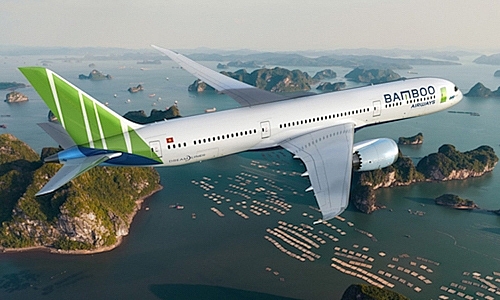Bamboo Airways rushing headlong into direct competition
 |
| Bamboo Airways claims they should be ready for commercial operations before the year is over |
Springing up like bamboo
“As scheduled, the Ministry of Transport (MoT) will grant the air transportation business license to Bamboo Airways Company Limited within this week,” a leader of the Department of Transportation told VIR.
The granting of the business license, which is the most important legal condition for an airline to begin commercial flights, is considered a done deal after the MoT’s proposal of granting Bamboo Airways the license was approved last week by the prime minster.
Although the appraisal procedures for issuing Bamboo Airways’ air transportation business license lasted for more than two months since the MoT petitioned the prime minister, the process was not a difficult one at all, according to experts who are used to seeing longer, more fraught negotiations and arrangements in the sector.
After receiving the business license, Bamboo Airways is required to complete another crucial procedure – securing the Aircraft Operator Certificate (AOC) – to be able to officially launch flights.
The AOC authorises an operator to carry out specified commercial air transport operations. This approval is by the National Aviation Authority (NAA) to an aircraft operator to allow it to use aircrafts for commercial purposes. This requires the operator to have personnel, assets, and systems in place to ensure the safety of its employees and the general public. This document defines the types of aircrafts which may be used, the purpose, and the geographic regions of operation.
“To be an official airline operating aircrafts and providing related services, Bamboo Airways needs an AOC and proofs that it has sufficient service quality, security system, and can ensure aviation safety,” Vo Huy Cuong, deputy head of the Civil Aviation Authority of Vietnam (CAAV), advised.
The designs of the first three Airbus A319 and A320 aircrafts is being completed by Bamboo Airways in Turkey and Philippines, and the planes will arrive to Vietnam soon.
Test flight results show that the airplanes meet the requirements and are ready for operation. This is ideal for the issuance of the AOC and the carrier might be able to launch its maiden commercial fight late in the fourth quarter of 2018.
Looking forward to the novelty
According to Bamboo Airways, the carrier will bring some 20 aircrafts to Vietnam within this year and add another 20-30 in 2019, following its operation plans. The new aircrafts from two contracts worth $8.8 billion with Airbus and Boeing are expected to be handed over by 2020.
Bamboo Airways plans to operate about 100 flight routes connecting all of the big cities and famous tourism destinations in Vietnam and around the world. The first domestic flights will be Hanoi-Quy Nhon, Hanoi-Dong Hoi, Ho Chi Minh City-Quy Nhon, Hanoi-Ho Chi Minh City, and Ho Chi Minh City-Van Don, with the intention to reduce the pressure on major cities’ aviation infrastructure, enhancing regional connections, and bring Vietnamese tourism to a new level.
With this flight network, Bamboo Airways intends to directly compete with the two giants, Vietnam Airlines Group and Vietjet, which are completely dominating the domestic aviation market.
The domestic market is currently a battlefield for four operational airlines, namely Vietnam Airlines (traditional four-star airline), Jetstar Pacific (low-cost airline), Vietnam Air Services Company (VASCO), and Vietjet. The first three airlines, which own a fleet of 108 aircrafts and belong to Vietnam Airlines Group, hold the upper hand in the variety of products (from four-star to budget flights), comprehensive infrastructure, logistics, and technical systems.
This may not be the right time for Bamboo Airways to break into the aviation market. After years of double-digit growth, which at its peak exceeded 20 per cent, the domestic aviation market has been witnessing a slowdown since mid-2017. In the first half of 2018, the total number of passengers in most routes, 16.8 million, increased by 7.9 per cent on-year, but fell 3.6 per cent short of forecasts.
Notably, on the three main domestic flight routes – Hanoi-Ho Chi Minh City, Hanoi-Danang, and Ho Chi Minh City-Danang – the respective on-year growth was only 4, 9.1, and 3.4 per cent.
Moreover, even if Bamboo Airways manages to launch its maiden commercial flight in December 2018, it will have missed the peak season of the 2019 Lunar New Year, as by then Tan Son Nhat and Noi Bai international airports will have arranged the slots for departing and arriving flights.
“Since the balance of power on the domestic aviation market has been set for more than three years, Bamboo Airways should somehow set themselves apart through both pricing and service quality. If they manage, the airline can begin profitable operations, as previously stated by the company leader,” an aviation expert said.
What the stars mean:
★ Poor ★ ★ Promising ★★★ Good ★★★★ Very good ★★★★★ Exceptional
Related Contents
Latest News
More News
- The destinations powering Vietnam’s festive season travel demand (December 04, 2025 | 18:33)
- Vietnam named among the world’s most exciting winter destinations (December 04, 2025 | 15:10)
- Phu Tho emerges as northern Vietnam’s new tourism hub (December 01, 2025 | 17:00)
- Vietjet completes Airbus A320/A321 updates ahead of deadline (December 01, 2025 | 09:49)
- Vietjet resumes Con Dao flights from early December (November 28, 2025 | 15:24)
- Free tickets, Lunar New Year promotions on offer at Vietjet Mega Livestream (November 26, 2025 | 15:32)
- Scandinavian Airlines and Vietnam Airlines broaden agreement with new routes (November 25, 2025 | 17:04)
- Halong Cruise Port welcomes over 3,100 international visitors (November 12, 2025 | 18:06)
- Vietnam.travel climbs to second place in Southeast Asia website rankings (November 12, 2025 | 18:01)
- Cat Ba named among Southeast Asia’s top island adventures (November 11, 2025 | 18:09)

 Tag:
Tag:


























 Mobile Version
Mobile Version